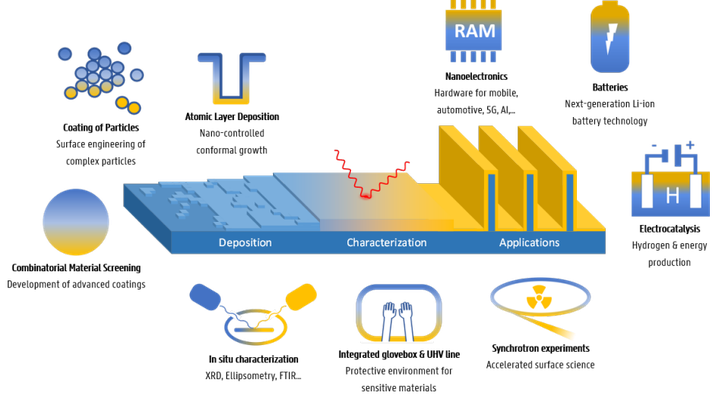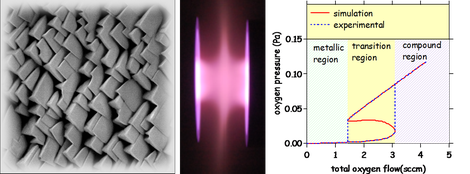Research
Research groups
Our department comprises 6 research groups, which study different fields of solid-state sciences.
- CoCooN focuses on all levels of thin film devices, from deposition to their different applications after extensive characterization.
- DiSC studies defects in semiconductors with the aid of FT-IR, DLTS, EPR and ENDOR.
- DRAFT is specialized in the experimental study and modelling of magnetron deposition.
- DyNaMat focuses on research on the dynamics of functional (magnetic) nanomaterials.
- LumiLab investigates inorganic materials for photo-, mechano- and persistent luminescence.
CoCooN
Research in the CoCooN group is directed at developing and understanding thin film materials within a context of applications relevant to society. We create thin films and nanomaterials – using Atomic Layer Deposition (ALD) for conformal coating of particles and nanostructures, and Combinatorial Deposition for fast screening of compositional libraries – and we systematically study their properties governed by their composition, structure, and surface and interface nature.
We are particularly interested in (1) physical phenomena that occur at surfaces and interfaces with a focus on solid-gas interfaces during ALD and solid-liquid interfaces during electrochemical energy conversion reactions, (2) solid state reactions that occur at the nanoscale with a focus on interface reactivity and solid state diffusion during annealing, and (3) ion transport in solid state nanoscale systems with a focus on systems relevant to battery and memory applications.
Understanding these fundamental aspects provides the necessary foundation for optimizing deposition processes and developing materials with an improved functionality for the targeted applications. We focus on materials for non-volatile memories and contacting materials for nano electronics, electrode materials and interfaces in Li-ion batteries and electrocatalysts for energy conversion.
DiSC
The research group DiSC aims to identify and quantify defects in semiconductors and insulating materials, in order to explain their effects on electrical and optical material and device properties. Semiconductors under study are Si, SiGe, SiC, chalcopyrites (e.g. CuInS2) and kesterites (e.g. Cu2ZnGeSe4), with applications in microelectronics, optoelectronics and photovoltaics (solar cells). Other materials under study are inorganic phosphors (e.g. rare-earth doped metal oxides) with applications in e.g. radiation dosimetry, and metal- and covalent organic frameworks with applications as heterogeneous catalyst.
Point and extended defects can introduce localized energy levels in the band gap of materials, which may act as trapping centers. In this way they can influence the lifetime of free charge carriers (and the luminescence lifetime), the leakage current of electronic devices and the efficiency of solar cells. Defects may also act as (semi)stable electron or hole traps in inorganic persistent or stored luminescence (TL, OSL) phosphors. We aim at determining electronic energy level positions, at structural identification and at quantification of defects. Such knowledge helps in understanding which defects are desired, which can be tolerated, and which should be avoided, and how the presence of such defects may be engineered.
The defect characterization techniques we primarily use are Fourier-transform infrared spectroscopy (FTIR), Deep-level transient spectroscopy (DLTS), and electron paramagnetic resonance (EPR and related techniques, e.g. ENDOR). The experimental information on defect characteristics and concentrations obtained through experiments are used to model the effect of defects via numerical modeling.
DRAFT
Understanding film growth during magnetron sputter deposition is the main focus of the DRAFT research group. The research is based on the solid foundation present in the research group on the development of the magnetron hardware. Two fundamental questions have driven the research up till now:
- What is the influence of the deposition conditions on the film growth ?
- What is the impact of reactive gas addition on the magnetron process?
The research group has set an own course seeking for answers on the two above mentioned fundamental questions, translated in the mission statement of the group : “At DRAFT we want to become the recognized leader in the understanding of thin film growth by reactive magnetron sputtering, and to enjoy research by experiments and simulations”. With this “target on growth” DRAFT can be your ideal partner for Dedicated Research on Advanced Films and Targets (DRAFT). We therefore look forward to collaborate with you, and extend our academic and industrial network.
DyNaMat
The DyNaMat (Dynamics of Functional Nanomaterials) research group focuses its research on functional magnetic materials and the fast magnetization dynamics in nanostructures. The methodology of our research group is based on the combination of experimental and numerical investigations. The experimental investigations are very time intensive, as extensive sample preparation is required. The numerical simulations however, rely on material parameters which are not always known in advance. For this reason, our group is continuously pushing the limits of fast time-resolved magnetic X-ray microscopy and ultra-fast magneto-optical experiments as well as the development of efficient micromagnetic codes.
Current research topics: skyrmions and chiral systems, nano magnetic logic, artificial spin ices, reservoir computing using magnetic systems, thermal magnetic noise, magnetic nanoparticles, domain wall dynamics in antiferromagnets
LumiLab
The research of the LumiLab team is mainly focused on inorganic luminescent materials (also known as phosphors), and studies the relation between the structural, electronic and optical characteristics of these materials. These phosphors generally consist of an insulating host compound – oxides, sulfides, nitrides, … - doped with luminescent ions. The dopants are most often rare earth elements; while the optical transitions in most rare earth elements are 4f-4f transitions, showing sharp excitation and emission features with low absorption strength, both Ce3+ and Eu2+ are rare earth ions offering broad excitation and emission bands that are highly tunable over the entire visible range. These properties make the latter ions omnipresent in white LEDs for lighting, where phosphors convert part of the light of a blue LED to green and red, ultimately leading to a broad spectrum mimicking natural white light. Due to the high cost and limited supply of rare earths, alternative dopants such as transition metals (Cr3+, Mn4+) and so-called s2-ions (Pb2+, Bi3+) are also explored. These alternative ions are also applied when emission in the near-infrared is needed, e.g. for applications in biological imaging.
Next to applications in lighting, phosphors are investigated showing mechanoluminescence (ML, useful for pressure sensing) and persistent luminescence ('glow-in-the-dark' materials for safety applications). Finally, LumiLab is active in a number of other projects on optically active ‘smart’ materials, such as Sm-chalcogenides as pressure-sensitive phase changing materials and photocatalytically active compounds for air purification.




